By Kollengode S Venkataraman
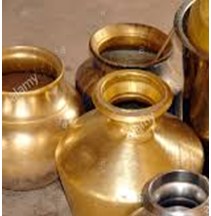
One of the rewards of aimless drifting on the web is the gems of information you unexpectedly get in the pile of worthless sand, known as gangue in the mining industry. It is like the story in the Yoga Vaasishtham: A miser desperately searching for the copper coin he dropped in the pile of rocks, after his long search, accidentally ends up with the chintamani — something like the philosopher’s stone — that would grant him all his wishes. The Chintamani story is another story for another day … Let us stay with copper for now.
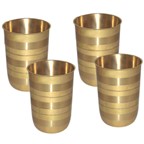
Many readers now in their 60s and 70s may remember growing up in simpler times in barely functional homes in Indian cities, towns and villages. Before the now ubiquitous stainless steel and aluminum invaded Indian kitchens, copper, copper alloys (brass and bronzes) and sterling silver were the metals of choice for vessels for storing water, cooking and eating.
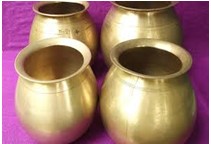
I still remember using brass vessels in our homes and the homes of my friends and relatives for storing water, and brass tumblers for serving water. The more affluent in South India used silver plates and tumblers for dinner ware. See the traditional copper/bronze cookware still available in India shown in pictures used in this story.
An important note: Many items commonly used in Indian cooking like tamarind (imli or puLi), lemons and lime (as juice, or as cut pieces in pickles), even milk, dahi, yogurt and buttermilk, all chemically react with copper and brass surfaces. This is because the acids (tartaric acid in tamarind, citric acid in lime, lemon and even in oranges, and lactic acid in milk and yoghurt and butter milk) used in cooking react with copper and brass surfaces. This releases copper and zinc tartarates, citrates, and lactates into the food prepared and stored and destroy the taste of the of food products. Traditional Indian women knew this very well, and never used copper/brass vessels for cooking that required boiling. But in Indian homes for storing water at room temperatures and serving water and eating food already prepared in meals, brass plates and tumblers were the choice.
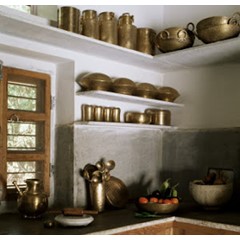
Today, copper, brass, silver and bronze utensils, plates and tumblers are gone in kitchens in middle class and above-middle-class homes all across India in the name of modernity. They were first replaced by stainless steel and aluminum. In recent decades, thermosetting plastics, glassware, and porcelain have entered the cookware market in big ways.
Among the working poor, however, copper and bronze are still used for storing water, cooking and eating. One hopes this stays this way. But plastics and aluminum are making inroads.
This is a great tragedy because copper and copper alloys have antibacterial, antifungal and antiviral — generically known as antimicrobial — properties even at room temperatures. This is something I came to know accidentally in my internet forays. This property of copper and copper alloys can be used cost-effectively for preventing to the extent possible water-borne diseases among the working poor. Poor water quality and sanitation facilities are the bane for the working poor in India. To mitigate this issue, all we need to do is to selectively reinvent copper and brass alloys in kitchenware through proper public health programs.
Here are fascinating reports that the simple copper and copper-rich alloys and the expensive silver have effective antimicrobial properties:
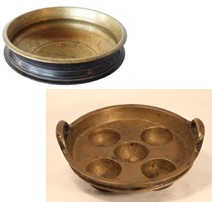
In controlled experiments in labs, when gram-positive and gram-negative bacteria came into contact with metallic copper as foils and plates in water at room temperatures, within in two hours, the water was purified of the disease-causing pathogens, with over 99% of the disease-causing pathogens getting killed. Here is the reference to the first technical paper: Antimicrobial Properties of Selected Copper Alloys on Staphylococcus aureus and Escherichia coli … … by a group of Polish healthcare professionals and metallurgists Anna Rozanska and coworkers. Reference: www.ncbi.nlm.nih.gov/pubmed/28726753.
Here is the authors’ conclusion in their study: “This study confirmed the antimicrobial properties of copper alloys, and additionally showed that Staphylococcus aureus (SA) was more resistant than Escherichia coli in the variant of the experiment without organic contamination. However, even for SA, a total reduction of the bacterial inoculum’s density took no longer than 2 h.†But stainless steel, the ubiquitous metal used today in India for cooking and eating did not have this beneficial property.
Modern medicine has been using silver ions in skin care and for healing wounds. In the prestigious journal Nature (June 19, 2013) is this article by Brian Owens on silver’s efficacy for fighting bacteria: Silver makes antibiotics thousands of times more effective: Ancient antimicrobial treatment could help to solve modern bacterial resistance. The title tells it all. Here is the reference for the article in Nature: www.nature.com/news/silver-makes-antibiotics-thousands-of-times-more-effective-1.13232.
A ton of information is available on the web on the antimicrobial properties on copper and silver. You can start in Wikipedia.
Water-borne diseases are a big problem in Africa and Asia and the Americas as well. People are advised to boil the water — at great expense given the high cost of fossil fuels, or fossil-fuel-generated electricity. So, maybe we need to reintroduce — and rediscover — copper and brass as complementing metals of choice Indian kitchens for storing and serving water in homes. This will help in cost-effectively managing water-borne diseases among the Indian poor, a chronic public health problem having great social and economic costs. End$$$$
